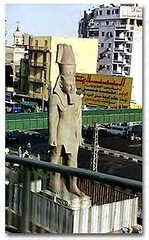EGYPT
Ramses gets huge Cairo send-off
Alain Navarro
Fri, 25 Aug 2006
Tens of thousands of people gathered along the streets of Cairo on Friday to bid farewell to one of Cairo's landmarks as the colossal statue of Ramses II began its journey from the polluted city to a spot near the Pyramids and closer to its original site.
After years of controversy and logistical headaches, the high-risk operation to move the 100-tonne, 11-metre high pink granite statue in one piece finally got underway at its scheduled time of 1:00 am (2200 GMT on Thursday).
Cairo residents of all ages and backgrounds took to the streets in the middle of the night to follow the statue of the greatest warrior king in ancient Egypt as it moved slowly through the city centre in its sarcophagus of scaffolding and protective plastic.
"We're going to miss you," shouted 12-year-old Issam Abu Zaid, as the floodlit convoy cranked into motion, starting Ramses' return journey from the square outside Cairo's main station to the Giza plateau.
The heart of one of the world's most populous cities turned into a huge carnival, as people put out flags on their balconies and climbed on lamp posts, buses, mosques and everything they could find to watch the statue go by.
Thousands of policemen were deployed in a desperate bid to form a cordon allowing for the safe passage of the convoy.
The statue — mounted on a huge mobile base and towed by a massive truck — was expected to take at least seven hours to complete the 35 kilometre journey.
Defeated by pollution in Africa's largest metropolis, the ancient warrior king will make his new home at the Grand Egyptian Museum, near the Giza Pyramids.
One of the city's most recognisable landmarks
The statue was brought to Cairo in 1954, where it soon became one of the most recognisable landmarks in the city, the first sight to greet passengers coming out of the train station.
Two years earlier, a group of young officers led by Gamal Abdel Nasser had overthrown British-backed King Farouk and abolished a monarchy which had become too closely associated with foreign powers.
Nasser wanted to use Ramses II — whose giant statue was discovered in 1882 in the ancient capital of Memphis — to symbolise the authentically Egyptian roots of the new republic.
"It was chopped up in eight pieces and reassembled. Not a single archeologist was present. It was the decision of a military dictatorship," said Zahi Hawass, the head of Egypt's antiquities.
"Ramses will be happy now," Hawass told AFP. "He would have been unhappy in his tomb knowing that the statue was staying in such a mess where nobody can see him anymore."
The transfer was practised last month with a fake statue, because Hawass said he "would not allow mistakes" and would take "all responsibility on himself."
Some opposed the transfer
Some Egyptian archeologists, politicians and intellectuals have opposed the transfer, alleging it was decided under US pressure because Ramses II — believed to be the pharaoh who oppressed the Jews and forced Moses to take his people out of Egypt — was perceived as an anti-Israeli symbol.
Hawass dismissed that view — relayed by one of his predecessors in the Egyptian press — as "totally stupid, cheap demagoguery".
In its early days, the statue and the fountain at its feet were visible from afar, but they were gradually hemmed in by a mass of overpasses and pedestrian bridges that were meant to ease the flow of people and motor traffic around and across the square but which in fact aggravated it.
The square, which lies outside the city's main train station, is reputed to be the most polluted spot in Egypt.
Blindfolded by a cast of plaster designed to protect it along the perilous transfer, the statue moved through the urban web of congested streets, flyovers and overpopulated buildings that make Cairo the largest metropolis in Africa.
Ramses II, from the 19th dynasty of pharaohs, reigned over Egypt for 68 years, from 1304 to 1237 BC, and is believed to have lived to the age of 90.
He covered the country with monuments to his exploits and his mummy, on display in the National Museum in Cairo, is one of the country's biggest tourist attractions.
AFP

No comments:
Post a Comment